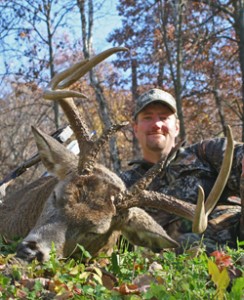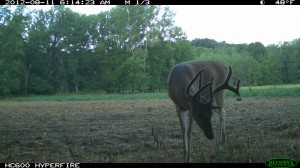Deer management
Deer Management from Differing Angles
Deer management is a passion for Steve.
By Steve Bartylla
As the deer began entering the isolated food plot, I was thrilled how things were shaping up. Despite having set the stand less than 2 hours before, the early arrivals showed no signs of being on edge. As I’d hoped, each made a beeline for the new

scrape tree 20 yards out from my stand. It was shaping up to be a good afternoon.
Sure enough, as the sun began setting, I spotted the mature 8 point working his way through the tall grass. After checking the doe at the far end of the food plot, he quickly turned his attentions to the group surrounding the scrape tree. Coming to full draw as he approached, I settled the pin and released the arrow. Twirling, one of the buck’s last acts was a failed attempt at plowing over the new tree.
At first glance, the tale of my hunt with Minnesota’s Fair Chase Outfitters appears to fit a management article because of the food plot. However, as you’ll soon find, there’s more to deer management than just food, killing does and allowing bucks to grow old.
So, before we begin, I should explain what I believe deer management involves. To me, it’s the combination of manipulating the population dynamics, improving the habitat for the deer and making the deer more easily killable.
Next, we need to dispel the myth that you need large chunks of land to accomplish a positive change. Sure, having 4000 contiguous acres helps. However, all of the practices you’ll read about were successfully applied to my own 200 acre lease.
Furthermore, these methods succeeded, despite my lease existing in an area not known as a big buck producer. Simply put, this form of deer management really can make a positive difference on both large and small properties.
Deer management – Manipulating the Numbers
When talking deer management, QDMA has drilled several concepts into our heads. The first is that reducing the doe numbers leads to more high quality nutrition being available for the remaining deer. In turn, they are otherwise healthier than if nutritionally stressed. This is a primary reason for killing does in overpopulated habitats.
Unfortunately, most Deer management on smaller pieces of ground see reducing doe numbers as a waste. They mistakenly reason that, since they can’t control what their neighbors do, their efforts are useless. That’s not true. Because does have a significantly smaller home range than bucks. Because of that, even those with as little as 20 acres can make a difference for their habitat by shooting does.
A side benefit of this is that, with fewer does, the bucks have to move more to find them. In turn, that makes bucks easier to kill.

The next QDMA Deer management slogan is to let the young bucks reach maturity. Though I’d argue with anyone that says there’s anything wrong with young bucks breeding does, that approach certainly does result in more mature bucks to hunt. The benefit to that is obvious.
The part of this equation that’s still missing is how in deer management bucks impact the potential trophy class bucks. “Killing as many inferior bucks as you can is absolutely critical,” said John Redmond, owner of Fair Chase Outfitters. “Everyone thinks you need to wait until bucks get old to shoot them, and then you kill the 7 and 8 points to remove their genetics. They have a point, but they fail to consider that those 7s and 8s are driving some of the bucks you really want to keep out.”
Dominance is decided by health, age and attitude. Because of that, that short browed, bruiser bodied 8 point is often the real bully, not the high racked 10. That can provide a big incentive for the 10 to shift his core area to avoid run ins with the 8. Therefore, killing the 8 can make the difference between you or the neighbor killing the 10. Ironically, this Deer management strategy applies even more to small tracts of land than large tracts.
Though many wait until a buck hits 4.5 years old to consider him a shooter, there are Deer management advantages to taking out those short tined 8s at 2.5 and 3.5 years old. “I have no doubt that one of the reasons we have so many great bucks here is because we are so aggressive at taking management bucks,” revealed Redmond. “That’s why we’ve taken 35 in the last 2 years. Since we began doing this, we’ve seen a jump in how many monsters decide to live the majority of their lives on our properties”
That’s also part of the reason I was so pleased to take the 8 that started this article. At 4.5 years old, he was a very respectable buck, but he never was going to hit Boone. On the same property, I shot a short browed, 3.5 year old 8 for the season before. In both cases, I passed several bucks that would have scored considerably higher, but had jaw dropper potential. Add in BHW’s own Lee Hetherington also taking a great, mature 8 point last season and you can start to see how serious Fair Chase is about this approach to Deer management.
Deer management – Setting the Table
For as good as that is for keeping the desirable bucks on a property, food plot Deer management strategies can also be a great aide. Take the long, windy ridge top I was setup on to begin this article. With wooded side hills dropping off to crop fields on both sides, the open top ranges from 100-200 yards wide. I strategically placed 4, 1-3 acre food plots along its half mile length.
This approach allows the ridge to comfortably hold more mature bucks. During the non-rutting portions of season, bucks travel very little. With the rest of the top being in native grasses, the bucks couldn’t see from one food plot to the next. Even though the plots were within easy walking distance of each other, it was rare for the same buck to show up on scouting cameras in more than one food plot.
That same Deer management approach worked well on my 200 acre lease. There, I created a string of 3 plots, ranging from 1/2 -1.5 acres in size. Because of the way the land laid, they were set up in a line, approximately 100 yards from the field edge,

and spaced less than 50 yards apart. In this case, the thick underbrush created privacy fences between them.
Because of their proximity to each other, it was more common to get the same mature buck’s pictures on an outside and the center plot. Interestingly, not once did I get the same buck on all 3 plots, until late October rolled around. The result was 2 mature buck’s being able to share the 200 acre lease, with their only real overlap occurring on the center food plot. As stated earlier, the exception was during the rut.
Another trick that helps is to have different plantings in each. Every food source has its most desirable growth stage. When planned correctly, having distinctly different plantings help cover the full season, as well as keep the big boys separated.
For example, on my lease, the eastern most plot was Antler King’s Trophy Clover with their Fall/Winter/Spring used as a cover crop. In this case, the clover served as a good early draw, where the winter rye covered the late season. The middle planting was their Red Zone, with the soybeans also being a good early and late draw. Finally, the western plot consisted of Antler King’s their Honey Hole, containing a mix of brassicas that remained desirable all season long.
This approach often results in the most dominant buck laying claim to the planting in its most desirable growth stage. Luckily, the subordinate bucks typically simply relocate their feeding to one of the other plots, since they also offer a desirable feeding option.
Another important addition is pairing each food plot with a water source. Between Fair Chase and my lease, all but one food plot had a dozer created pond. At the location the dozer couldn’t reach, I simply cut a two foot section of a plastic drum and buried it in a low spot. Sinking the lip to just below ground level and packing dirt tightly around the edge allowed the runoff to keep it full the majority of the time. In all cases, the water sources at each food plot location further helped to keep the bucks to their own separate areas.
Furthermore, locating relatively small plots back from the crop fields creates ideal staging areas. This was clearly illustrated on my lease, where the hunters sitting the field edges saw pitifully few deer. Yet, despite only being 100 yards away, I was covered up nearly every sit. The hidden Deer management advantage to this is how it saves deer from neighbors and poachers.
Deer management – Managing for the Kill
Once the rut kicks in, the buck segregation effect from the string of food plots is lost. However, a new advantage appears. During the rut, bucks typically check the entire string of food plots for hot does. That makes selecting which to sit far less important and increases the odds of tagging any mature buck that’s active on the property.
Obviously, keeping the plots relatively small also helps increase the percentage of shot opportunities at the deer that enter them. Still, plots even a half acre in size can allow bucks to cut a corner without offering a shot.
Shaping the plots in Us and Vs help reduce that occurrence. Provided the cover is thick enough to shield a buck’s view of the opposite end, it forces him to middle to check the entire plot for does. Placing stands on the inside and outside edge of the center allows for most wind directions to work, as well as providing the highest percentage of shots.
Still, that approach isn’t always practical. For example, the food plot I was hunting at Fair Chase is surrounded by a mature oak flat. The tall native grasses helped some, but they weren’t tall enough to be used as an effective privacy fence. That’s where the lick tree came into play.
“When Steve called on his drive over to ask if I had a post hole digger and a saw he could borrow, I was almost afraid to ask why,” John Redmond recalled. “When he explained what he needed it for, I thought he was a little nuts. I changed my mind on that real fast.”
Since the food plot was too big to cover, I simply cut a small oak and “planted” it 20 yards in front of my stand. From past experiences, I was confident that all the bucks would check a scrape tree that stood out so prominently. Sure enough, every buck did, including the one I shot. When I returned the next morning to take pictures, two fresh scrapes had already appeared under its branches. This Deer management technique has now become a well used tool in Fair Chase’s bag of tricks.
For this to work effectively, just make sure you cut a tree with ample licking branches. Next, bury the base around 2.5 feet deep. Odds are good that it will also be rubbed. So the depth and packing it in good with dirt is important to keep it upright.
Another very trick is to create licking branches from nearby trees along the edge. In many cases, branches can be bent to hang into the plot at nose level. When that’s not possible, one can wire or nail branches to the trees and accomplish the same thing.
Though neither approach works as well as “planting” a tree in the plot, it still does help bring more deer into bow range. So long as we are going to manage deer, we may as well increase our shot opportunities as much as reasonably possible.
Conclusion
Though having the quantity of land Fair Chase Outfitters has certainly helps for Deer management, one can produce great results on far less. The trick is really giving deer everything they want, hunting it smart, to allow them to feel safe, and stacking the odds through food plots, water and deer management.
In the case of my 200 acre lease, I knew the age structure just wasn’t there the first year I leased it. So, I didn’t hunt it that year. Instead, I made sure the deer had ample food, no reason to leave and gave them a year to grow up. My Deer management efforts paid off handsomely the second season, with my taking of a 4.5 year old, wide 10 point.
In years past, I owned a 40 acre piece of ground. Again, it was in a poor trophy buck area, surrounded by heavy hunting pressure. These same Deer management principles allowed me to take several mature bucks from that property, as well.
I could provide many more examples, but the point is the same in each. Believing you need a lot of land to produce results is simply not true. Regardless of if you have 40 or 4000 acres to hunt, I encourage you to give these Deer management techniques a try. You just may be pleasantly surprised with the results.
A Closer Look at deer management and Fair Chase Outfitters Sidebar
Houston, Minnesota’s Fair Chase Outfitters is a 4000 contiguous acre chunk of prime whitetail habitat. Having practiced deer management for almost 10 years, this nearly exclusively bow only operation, from its accommodations to opportunities at trophy bucks, is one of the finest I’ve ever had the pleasure to hunt.
So, what makes Fair Chase such a primo place to bag a buck of a lifetime? The simple answer is that owner, John Redmond set the goal of creating a whitetail hunting utopia. Next, there’s the top end staff. Head guide, Chris Behrens know both mature bucks and the areas rolling timber like the back of his hand. I also contribute as a Deer management habitat consultant. Together, we share the common goal of making Fair Chase the best it can be. Of course, that’s helped greatly by having superior ground to manage.
Next, one must add in the staggered timber stand Deer management improvement plan, which results in a wide range of thick and nasty areas to more open oak flats. The introduction of native grasses provides extra protective cover. Then, top that off with numerous ponds strategically located food plots.
Finally, one must add all of this to Fair Chase’s aggressive Deer management doe and management buck harvest plans. The end result is superior habitat that the resident bucks have less desire to leave. In turn, that plays beautifully into their plans of making the remaining monsters more killable.
For a comprehensive Deer management guide to cutting edge stand hunting methods, check out Steve Bartylla’s book: Advanced Stand Hunting Strategies. A personally autographed copy can be yours for $22.50, tax and shipping included.
Steve’s newest book — Bowhunting Tactics That Deliver Trophies — serves as an excellent compliment and delves deeply into the critical details of Deer management that must be addressed to consistently arrow the big boys. An autographed copy of this hardcover sells for $30. For either Deer management or both ($50 when ordered together), send a check or money order to the following:
Deer management
Steve Bartylla
1406 St Joseph Ave
Marshfield, WI 54449
Be sure to include your name and the shipping address and be on you way with new Deer management tips, Deer management techniques and Deer management ideas. Deer management is a complicated and fun road, so enjoy the ride.

